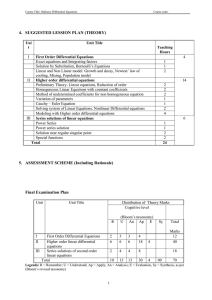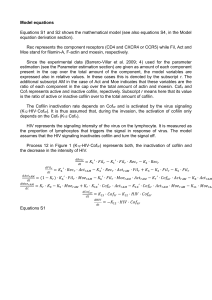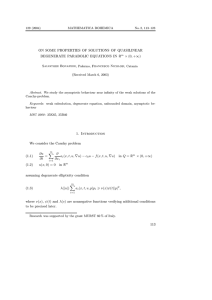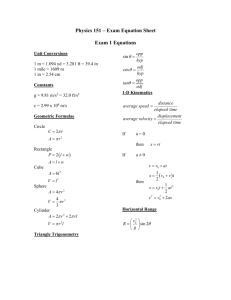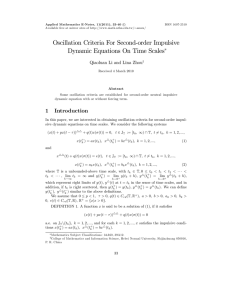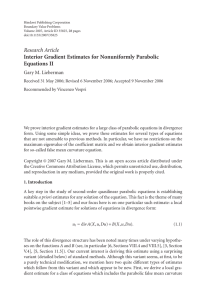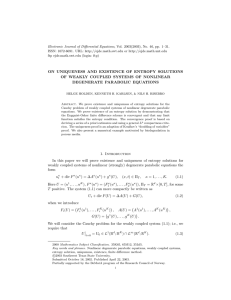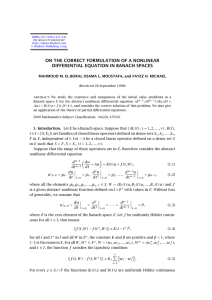A NONLOCAL PARABOLIC SYSTEM WITH APPLICATION TO A THERMOELASTIC PROBLEM
advertisement
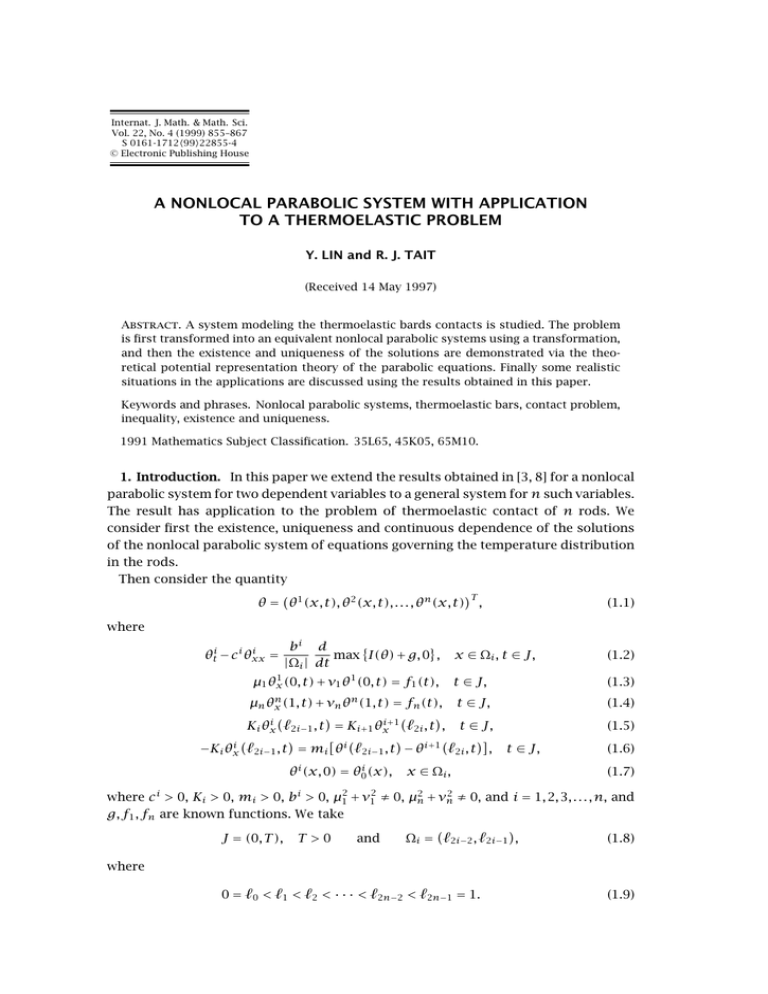
Internat. J. Math. & Math. Sci.
Vol. 22, No. 4 (1999) 855–867
S 0161-17129922855-4
© Electronic Publishing House
A NONLOCAL PARABOLIC SYSTEM WITH APPLICATION
TO A THERMOELASTIC PROBLEM
Y. LIN and R. J. TAIT
(Received 14 May 1997)
Abstract. A system modeling the thermoelastic bards contacts is studied. The problem
is first transformed into an equivalent nonlocal parabolic systems using a transformation,
and then the existence and uniqueness of the solutions are demonstrated via the theoretical potential representation theory of the parabolic equations. Finally some realistic
situations in the applications are discussed using the results obtained in this paper.
Keywords and phrases. Nonlocal parabolic systems, thermoelastic bars, contact problem,
inequality, existence and uniqueness.
1991 Mathematics Subject Classification. 35L65, 45K05, 65M10.
1. Introduction. In this paper we extend the results obtained in [3, 8] for a nonlocal
parabolic system for two dependent variables to a general system for n such variables.
The result has application to the problem of thermoelastic contact of n rods. We
consider first the existence, uniqueness and continuous dependence of the solutions
of the nonlocal parabolic system of equations governing the temperature distribution
in the rods.
Then consider the quantity
T
(1.1)
θ = θ 1 (x, t), θ 2 (x, t), . . . , θ n (x, t) ,
where
i
=
θti − c i θxx
bi d
max I(θ) + g, 0 ,
|Ωi | dt
µ1 θx1 (0, t) + ν1 θ 1 (0, t) = f1 (t),
x ∈ Ωi , t ∈ J,
(1.2)
t ∈ J,
(1.3)
µn θxn (1, t) + νn θ n (1, t)
(1.4)
Ki θxi
(1.5)
= fn (t), t ∈ J,
2i−1 , t =
2i , t , t ∈ J,
−Ki θxi 2i−1 , t = mi θ i 2i−1 , t − θ i+1 2i , t ,
i
Ki+1 θxi+1
θ (x, 0) =
θ0i (x),
x ∈ Ωi ,
t ∈ J,
(1.6)
(1.7)
2
+ νn2 ≠ 0, and i = 1, 2, 3, . . . , n, and
where c i > 0, Ki > 0, mi > 0, bi > 0, µ12 + ν12 ≠ 0, µn
g, f1 , fn are known functions. We take
J = (0, T ), T > 0
and
Ωi = 2i−2 , 2i−1 ,
(1.8)
where
0 = 0 < 1 < 2 < · · · < 2n−2 < 2n−1 = 1.
(1.9)
856
Y. LIN AND R. J. TAIT
The integral operator I(θ) is defined by
n
ai
θ i (x, t) dx,
I(θ) =
Ωi
i=1
ai > 0, t ∈ J.
(1.10)
The quantities f1 (t), fn (t), θ0i (x) are taken to be known functions.
Definition 1.1. A vector θ is said to be a solution to the problems (1.2)–(1.10) if
θ ∈ C 2 (Ωi × J) ∩ L∞ (Ωi × J) and satisfies equation (1.2) together with the initial and
boundary conditions almost everywhere.
i
2. An equivalent problem. The problem described by equations (1.1)–(1.10) can be
reduced to an equivalent problem by setting
w i = θi −
bi
max I(θ) + g, 0 ,
|Ωi |
i = 1, . . . , n.
(2.1)
Multiplying each of equations (2.1) by ai in turn and integrating over Ωi and summing
we have
n
I(w) = I(θ) − ai bi max I(θ) + g, 0 ,
(2.2)
i=1
1
2
n T
where w = (w , w , . . . , w ) . If we add g to either side we have
n
i
ai b max I(θ) + g, 0 .
I(w) + g = I(θ) + g −
Lemma 2.1. If Q = 1 −
n
i=1 ai b
(2.3)
i=1
i
θi = w i +
> 0 then equation (2.1) has the unique inverse
bi
max I(w) + g, 0 .
|Ωi |Q
(2.4)
Proof. Equation (2.3) implies that
I(w) + g > 0 ⇐⇒ I(θ) + g > 0,
(2.5)
and the result follows.
In terms of w the problem described by equations (1.1)–(1.10) may be reformulated
for i = 1, 2, . . . , n as
i
wti − c i wxx
= 0,
x ∈ Ωi ,
t ∈ J,
max I(w) + g, 0 = f1 (t),
b1
t ∈ J,
|Ω1 |Q
bn
µn wxn (1, t) + νn w n (1, t) +
max I(w) + g, 0 = fn (t), t ∈ J,
|Ωn |Q
Ki
wxi+1 2i , t =
w i 2i−1 , t , t ∈ J,
Ki+1 x
mi
wxi 2i−1 , t = −
w i 2i−1 , t − w i+1 2i , t
Ki
Hi
+
max I(w) + g, 0 , t ∈ J,
Q
µ1 wx1 (0, t) + ν1 w 1 (0, t) +
(2.6)
(2.7)
(2.8)
(2.9)
(2.10)
857
A NONLOCAL PARABOLIC SYSTEM . . .
w i (x, 0) = θ0i (x) +
bi
max I(w0 ) + g, 0 ,
|Ωi |Q
x ∈ Ωi .
(2.11)
Since the initial values θ0i (x), i = 1, 2, . . . , n are known we take
w i (x, 0) = Φi (x),
x ∈ Ωi ,
(2.12)
to be known quantities.
3. Preliminaries. In this section we list several classical results from [4] and develop solutions to the problems (2.6)–(2.12). We refer to [4] for proofs of the following
lemmas:
Lemma 3.1. If Φ(x) ∈ C[0, 1], then
1
Θ x + ξ, t + Θ x − ξ, t Φ ξ dξ
V x, t, φ =
0
(3.1)
solves the problems
Vt = Vxx ,
0 < x < 1, t > 0,
V (x, 0) = Φ(x),
0 < x < 1,
Vx (0, t) = Vx (1, t) = 0,
(3.2)
t > 0.
Here we have defined
1
2
e−x /4t , t > 0,
2π t
∞
Θ(x, t) =
K(x + 2n, t), t > 0.
K(x, t) = √
(3.3)
(3.4)
n=−∞
Lemma 3.2. Let w(x, t) be the solution of
wt = wxx ,
w(x, 0) = Φ(x),
w(0, t) = F (t),
0 < x < 1, t > 0,
0 < x < 1,
(3.5)
wx (1, t) = G(t),
t > 0,
where F , G ∈ C[0, T ], T > 0, Φ ∈ C[0, 1]. Then
t
t
w(x, t) = V (x, t, Φ) − 2 Kx (x, t − s)ψ1 (s) ds + 2 K(x − 1, t − s)ψ2 (s) ds,
(3.6)
where ψ1 , ψ2 are the unique solutions in C[0, T ] of the Volterra system
t
F (t) = V (0, t, Φ) + ψ1 (t) + 2 K(−1, t − s)ψ2 (s) ds,
(3.7)
0
G(t) = −2
0
t
0
0
Kxx (1, t − s)ψ1 (s) ds + ψ2 (t).
(3.8)
Note. (i) If F , G are piecewise continuous and bounded, then Lemma 3.2 holds
with ψ1 , ψ2 piecewise continuous and bounded.
(ii) If F and G have a singularity at t = 0 with F (t) = G(t) = O(t −α ), 0 < α < 1, then
ψ1 , ψ2 have the same singularity at t = 0.
(iii) If F and G ∈ L1 (0, T ), then ψ1 , ψ2 ∈ L1 (0, T ) and the solution w ∈ L1 [(0, 1) ×
(0, T )].
858
Y. LIN AND R. J. TAIT
Lemma 3.3. Let w(x, t) be the solution of
wt = wxx ,
0 < x < 1, t > 0,
w(x, 0) = Φ(x),
0 < x < 1,
wx (0, t) = H(t),
(3.9)
wx (1, t) = J(t),
t > 0,
where F , G ∈ C[0, T ], Φ ∈ C[0, 1]. Then
w(x, t) = V (x, t, Φ) − 2
t
0
K(x, t − s)H(s) ds + 2
t
0
K(x − 1, t − s)J(s) ds.
(3.10)
Extensions. We require the following corollaries of Lemmas 3.2 and 3.3 to adapt
the solutions to the intervals of interest for the problems (2.6)–(2.12).
Corollary 3.1. With the assumptions of Lemma 3.2 the solution of
1
wt1 = c 1 wxx
,
1
1
x ∈ Ω1 , t > 0,
wx1 (1, t)
w (0, t) = F (t),
1
1
w (x, 0) = Φ (x),
= G1 (t),
t > 0,
(3.11)
1
x∈Ω ,
is given by
1
w (x, t) = V
1
1
1
x, t, Ω , c , 1 − 2
0
Kx
c1 1
x c1
, 2 (t − s)
ψ (s) ds
1 1
1 1
x − 1 c 1
c1
+2 K
, 2 (t − s) 2 ψ21 (s) ds,
1
1
1
0
t
t
(3.12)
where ψ11 , ψ12 are the unique solutions of the Volterra system
1
F (t) = V
1
0, t, Φ1 , c
1
, 1 + ψ11 (t) + 2
t
c1
c1
K − 1, 2 (t − s) 2 ψ21 (s) ds,
1
1
0
t
c1
(t − s) ψ11 (s) ds + ψ21 (t),
12
0
x + ξ c1
x − ξ c1
1 1
1
1 1
θ
,
t +θ
,
t
Φ1 ξ dξ.
V x, t, Φ , c , 1 =
1 0
1 12
1 12
2G1 (t) = −2c 1
Kxx 1,
(3.13)
(3.14)
(3.15)
= x/1 , t = c 1 t/12 in equations (3.11), and consider Lemma 3.2 in
Proof. Set x
t.
terms of the new variables x,
Corollary 3.2. With the assumptions of Lemma 3.3, the solution of
j
j
wx 2j−2 , t
j
wt = c j wxx ,
j
= H (t),
j
x ∈ Ωj , t > 0,
j
wx 2j−1 , t = J j (t),
w (x, 0) = Φj (x),
x ∈ Ωj
t > 0,
(3.16)
859
A NONLOCAL PARABOLIC SYSTEM . . .
for j = 2, 3, . . . , n − 1 is given by
w j (x, t) = V 2 x, t, Φj , c j , 2j−2 , 2j−1
t x − 2j−2
c j (t − s)
−2 K
,
c j H j (s) ds
2j−1 − 2j−2 |Ωj |2
0
t x − 2j−2 c j (t − s)
+2 K
,
c j J j (s) ds,
|Ωj |
|Ωj |2
0
(3.17)
where
V 2 x, t,Φj , c j , 2j−2 , 2j−1
(3.18)
x + ξ − 22j−2 c j t
1
x − ξ cj t
=
,
,
θ
+
θ
Φj ξ dξ.
|Ωj | Ωj
|Ωj |
|Ωj |2
|Ωj | |Ωj |2
= (x − 2j−2 )/|Ωj |, t = c j t/|Ωj |2 and proceed as in Corollary 3.1.
Proof. Set x
Corollary 3.3. With the assumptions of Lemma 3.2, the solution of
n
, x ∈ Ωn , t > 0,
wtn = c n wxx
n
w n (1, t) = F n (t),
2n−2 , t = G (t),
n
wx
w n (x, 0) = Φn (x),
t > 0,
(3.19)
x ∈ Ωn ,
is given by
w n (x, t) = V 3 x, t, Φn , c n , 2n−2
t x − 2n−2 c n (t − s)
cn
+2 K
ψn (s) ds
,
2
|Ωn |
|Ωn |
|Ωn |2 2
0
t
c n (t − s)
x − 2n−2
cn
− 1,
ψn (s) ds,
+ 2 Kx
2
|Ωn |
|Ωn |
|Ωn | 1
0
(3.20)
where ψ1n , ψ2n are the unique solutions of the Volterra system
t c n (t − s)
cn
F n (t) = V 3 1, t, Φn , c n 2n−2 + ψ1n (t) + 2 K 1,
ψn (s) ds, (3.21)
2
|Ωn |
|Ωn |2 2
0
t
c n (t − s)
|Ωn |Gn (t) = 2c n Kxx − 1,
(3.22)
ψ1n (s)ds − ψ2n (t),
|Ωn |2
0
V 3 x, t, Φn , c n , 2n−2
(3.23)
1
x + ξ − 22n−2 c n t
x − ξ cnt
=
,
,
Φn ξ dξ.
θ
+
θ
2
2
|Ωn | Ωn
|Ωn |
|Ωn |
|Ωn | |Ωn |
= (1 − x)/(1 − 2n−2 ), t = c n t/|Ωn |2 first, and proceed as in CorolProof. Set x
lary 3.1.
We now set
j
ψ1 = H j (t),
j
ψ2 (t) = J j (t),
j = 2, 3, . . . , n − 1.
(3.24)
860
Y. LIN AND R. J. TAIT
Clearly, once
T
ψ = ψ11 , ψ21 , . . . , ψ1n , ψ2n
(3.25)
is determined uniquely, the solution to our problem is known.
We will show that ψ satisfies a matrix Volterra system of the form
t
t
ψ(t) = G(t) + A(t − s)ψ(s) ds + M max H(t) + B(t − s)ψ(s) ds, 0 ,
0
0
(3.26)
where G, H are suitable vectors and A, M, B suitable matrices. We require the following
lemma:
Lemma 3.4. Let
T
G(t) = G1 , G2 , . . . , GN ∈ [ᏸ1 (0, T )]N ,
T
H(t) = H1 , H2 , . . . , HN ∈ [ᏸ1 (0, T )]N ,
(3.27)
and let the N × N matrices
A(t) =
aij (t) ,
B(t) =
bij (t) ,
M(t) =
mij (t) ,
i, j = 1, 2, . . . , N, be such that for some constants Ca , Cb , Cm > 0, 0 < α < 1,
A = max aij ≤ Ca t −α ,
i,j
B = max bij ≤ Cb t −α , where t > 0.
i,j
M = max Mij ≤ Cm t −α ,
(3.28)
(3.29)
i,j
Then the system (3.26) has a unique solution ψ(t) ∈ [L(0, T )]N . In particular if ψ1 , ψ2
are two solutions corresponding to data G1 , H1 , and G2 , H2 respectively then there exists
a constant C = C(Ca , Cb , Cm , α, T ) > 0 such that
T
T !
"
ψ1 − ψ2 dt ≤ C
(3.30)
G1 − G2 + H1 − H2 dt,
0
where ψ =
0
N
i=1 |ψi |.
Proof. See [8].
4. Existence and uniqueness. We rewrite equations (2.7), (2.8), (2.9), and (2.10) in
the form
b1
S ψ ,
|Ω1 |Q
bn
w n (1, t) = fn (t) −
S ψ ,
|Ωn |Q
Kj
j+1 j
wx 2j−1 , t ,
wx 2j , t =
Kj+1
Hj mj
j
wx 2j−1 , t = −
w j 2j−1 , t − w j+1 2j , t + 1 S ψ
Kj
Q
w 1 (0, t) = f1 (t) −
(4.1)
(4.2)
(4.3)
(4.4)
861
A NONLOCAL PARABOLIC SYSTEM . . .
for j = 1, 2, . . . , n − 1.
2
+ νn2 ≠ 0 we have considered the typical case
Since µ12 + ν12 ≠ 0, µn
µ1 = µ2 = 0,
ν1 = ν2 = 1.
(4.5)
The general case will follow by similar arguments. Since, as we pointed out earlier,
Φj (x) are known for j = 1, 2, . . . , n we have taken V 1 , V 2 , V 3 as known quantities. Further, since each element w j , j = 1, . . . , n can be expressed in terms of the appropriate
elements of ψ we have written, for the moment,
I∗ ψ = I w ψ .
(4.6)
S ψ = max I ∗ ψ + g, 0 ,
We again note that
Hj =
bj+1
bj
−
,
|Ωj | |Ωj+1 |
j
ψ1 = H j ,
j
ψ2 = J j .
(4.7)
Equations (2.10) may now be used to determine equations for ψ2i , i = 1, 2, . . . , n−1 and
the last of equations (2.9) (i = n − 1) to determine ψ2n as follows.
For i = 1 equations (2.10), together with equations (3.14) and (3.17) give
ψ21 (t) =
"
m1 1 ! 2 V 2 , t, Φ2 , c 2 , 2 , 3 − V 1 1 , t, Φ1 , c 1 , 1
K1
t
c 1 (t − s)
1
+ 2c
ψ11 (s) ds
Kxx 1,
|Ω1 |
0
t
m1 1
c 1 (t − s)
c1
ψ1 (s) ds
−
− 2 Kx 1,
2
K1
|Ωn |
|Ω1 |2 1
0
t c 1 (t − s)
c1
+ 2 K 0,
ψ1 (s) ds
2
|Ω1 |
|Ω1 |2 2
0
t c 2 (t − s) 2 2
+ 2 K 0,
c ψ1 (s) ds
|Ω2 |2
0
t m
c 2 (t − s) 2 2
1
H S ψ ,
ψ
(s)
ds
+
− 2 K − 1,
c
2
K1 Q 2
|Ω2 |2
0
and for j = 2, . . . , n − 1 we have, using Corollary 3.2 and equation (4.7),
"
mj ! 2 j
V 2j , t, Φj+1 , 2j , 2j+1 − V 2 2j−1 , t, Φj , 2j−2 , 2j−1
ψ2 =
Kj
t mj
c j (t − s) j j
− 2 K 1,
c ψ1 (s) ds
−
Kj
|Ωj |2
0
t c j (t − s) j j
+ 2 K 0,
c ψ2 (s) ds
|Ωj |2
0
t
c j+1 (t − s) j+1 j+1
+ 2 K 0,
c ψ1 (s) ds
|Ωj+1 |2
0
t m H c j+1 (t − s) j+1 j+1
j j
− 2 K − 1,
S ψ .
c ψ2 (s) ds −
2
|Ωj+1 |
Kj Q
0
(4.8)
(4.9)
862
Y. LIN AND R. J. TAIT
Next, from equations (2.9) with i = n − 1 and equation (3.22), we have
t
c n (t − s)
Kn−1 n−1
ψ2n = −|Ωn |
ψ1n (s) ds,
ψ2 (t) − 2c n Kxx − 1,
Kn
|Ωn |2
0
where ψ2n−1 is given in equations (4.9).
(4.10)
j
We next turn to equations (4.8), (4.9), and (4.10) for ψ1 (t), j = 1, 2, . . . , n. Using
equations (4.1), (4.2), and equations (3.13), (3.21) we have
ψ11 (t) = f1 (t) − V 1 0, t, Φ1 , c 1 , 1
t 1
(4.11)
c1
c
b1
− 2 K − 1,
S ψ ,
(t
−
s)
ψ21 (s) ds −
2
2
|Ω
|
|Ω
|
|Ω
|Q
0
1
1
1
n
3
ψ1 (t) = fn (t) − V 1, t, Φn , 2n−2
t (4.12)
c n (t − s)
bn
cn
S ψ ,
ψ2n (s) ds −
− 2 K 1,
2
2
|Ωn |
|Ωn |
|Ωn |Q
0
while the first of equations (4.3), i = 1, gives
t
K1
c 1 (t − s)
2
1
1
1
ψ1 (t) =
Kxx 1,
ψ1 (s) ds ,
ψ2 (t) − 2c
1 K2
|Ω1 |2
0
(4.13)
where again ψ21 is given in equation (4.8).
The remaining equations (4.3) for i = 2, . . . , n − 2 give
j
ψ1 (t) =
Kj
j−1
ψ (t),
Kj+1 2
j = 3, 4, . . . , n − 1
(4.14)
with the right hand sides given in equations (4.9).
Clearly the set of equations for ψ have the form given in equations (3.26) and it
remains to establish suitable estimates.
Lemma 4.1. The unique solution {ψ1i , ψ2i }, i = 1, 2, . . . , n, exist for systems (4.8)–
(4.14) and there exists C > 0 such that
T n T i
ψ − ψ i + ψi − ψ i dt ≤ C
g − g + f1 − f + fn − f dt, (4.15)
1
n
1
2
1
2
i=1
0
0
i
i
where {ψ1i , ψ2i } and {ψ1 , ψ2 } are the solutions with the data {g, f1 , fn } and {g, f 1 , f n },
respectively.
Proof. By Lemma 3.4 it is sufficient to estimate the kernel. Clearly it is from
Cannon [4] that
|K(±1, t)| + |Kxx (±1, t)| + |Kx (±1, t)| ≤ C,
t>0
(4.16)
and
C
|K(0, t)| ≤ √ ,
t
t > 0.
Thus, the assumptions of Lemma 3.4 are satisfied and Lemma 4.1 follows.
(4.17)
863
A NONLOCAL PARABOLIC SYSTEM . . .
Theorem 4.1. The system (1.1)–(1.10) possesses a unique solution which depends
continuously upon the data.
Proof. It follows from Lemma 4.1 and the equivalence analysis in Section 2.
5. Application to thermoelastic bars. Consider n thermoelastic bars lying along
the positive x axis with the ith bar, 1 ≤ i ≤ n, occupying the interval Ωi . We use the
notation of Section 1. The equations describing the displacements and temperature
distributions are given by
Ki αi θ0 ui xt + ci θ i t = ki θ i xx , x ∈ Ωi ,
σi = λi + 2µi (ui )x − Ki αi (θ i − θ0 ), x ∈ Ωi ,
(σi )x = 0,
x ∈ Ωi
(5.1)
(5.2)
(5.3)
for i = 1, 2, . . . , n, t ∈ J. ui (x, t) denotes the displacement and θ i (x, t) the temperature
of the ith bar at position x and time t. σi (x, t) represents the corresponding stress
and ci , ki , αi are constants, i = 1, 2, . . . , n, denoting the heat capacity, conductivity
and coefficient of thermal expansion, respectively, of the ith bar. θ0 is a reference
temperature, measured in degrees Kelvin, normally taken as the ambient temperature.
It is convenient to nondimensionalize the quantities of interest and we set
πi ui
,
L
=
x
x
,
L
i =
u
i =
σ
σi
,
Ki
θ i − θ0
θi =
,
θ0
t =
πi2 =
k1 t
,
c1 L2
(λi + 2µi )k1
,
c1 θ0 ki
(5.4)
where
Ki = 3λi + 2µi
(5.5)
for i = 1, 2, . . . , n. The quantities λi , µi are the Lamé elastic constants.
i, i =
∈Ω
The intervals x ∈ Ωi are replaced with the corresponding intervals x
1, 2, . . . , n. If the above quantities are substituted in equations (5.1), (5.2), and (5.3)
and subsequently the hats dropped we have the equations in the following nondimensional form
di θ i t − θ i xx = −ai (ui )xt , x ∈ Ωi ,
σi = βi (ui )x − ai θ i , x ∈ Ωi ,
(σi )x = 0,
x ∈ Ωi
(5.6)
(5.7)
(5.8)
for i = 1, 2, . . . , n, where
di =
ci k1
,
c1 ki
βi =
λi + 2µi
,
Ki πi
ai =
αi Ki k1
.
c1 πi ki
(5.9)
Clearly equation (5.8) implies that
σi = σi (t),
i = 1, 2, . . . , n.
(5.10)
864
Y. LIN AND R. J. TAIT
Since (5.10) holds this implies that if one end of any of the bars is free then σi (t) = 0,
i = 1, 2, . . . , n whereas if all of the bars are in contact then σi (t) ≤ 0, i = 1, 2, . . . , n.
In addition to the governing equations we require the initial and boundary conditions. The conditions on the θi (x, t) are given in equations (1.3) through (1.7). For the
moment we require only the initial conditions, namely,
θ i (x, 0) = θ0i (x),
x ∈ Ωi , i = 1, 2, . . . , n,
(5.11)
together with the conditions
u1 (0, t) = 0,
un (1, t) = 0.
(5.12)
There are essentially two cases to consider depending on whether all bars are in contact or not. There are then subcases depending on how the bars are grouped in contact.
The difficulties are the same whether we consider n bars or three bars. The latter case
simplifies and clarifies the procedure and we now confine our attention to that case.
The generalization required for n bars then follows.
We consider then three bars lying along the positive x axis lying in the intervals
Ω1 = [0, 1 ], Ω2 = [2 , 3 ], Ω3 = [4 , 1] where
0 < 1 ≤ 2 < 3 ≤ 4 < 1,
(5.13)
and set
g 1 = 1 − 2 ,
g2 = 4 − 3 .
We begin by considering the initial conditions. Set
x
θ 1 (s, t) ds, 0 ≤ x ≤ 1 ,
Θ1 (x, t) = a1
0
Θ2 (x, t) = a2
Θ3 (x, t) = a3
x
2
1
x
(5.14)
(5.15)
θ 2 (s, t) ds,
2 ≤ x ≤ 3 ,
(5.16)
θ 3 (s, t) ds,
4 ≤ x ≤ 1.
(5.17)
From equations (5.11), θi (x, 0), i = 1, 2, 3 are known, so that Θi (x, 0) are known. There
are two cases.
Case I. If
(5.18)
u1 1 , 0 < u2 2 , 0 + g1
or
u2 3 , 0 < u3 4 , 0 + g2 ,
(5.19)
then σi (0) = 0, i = 1, 2, 3.
Using equations (5.7) and (5.12) we have
u1 (x, 0) = Θ1 (x, 0),
0 ≤ x ≤ 1 ,
u2 (x, 0) = u2 (2 , 0) + Θ2 (x, 0),
u3 (x, 0) = −Θ3 (x, 0),
2 ≤ x ≤ 3 ,
4 ≤ x ≤ 1.
(5.20)
(5.21)
(5.22)
A NONLOCAL PARABOLIC SYSTEM . . .
865
If equation (5.18) does not hold but (5.19) does then
u2 2 , 0 = Θ1 1 , 0 − g1 ,
(5.23)
whereas if (5.18) holds and (5.19) does not
u2 2 , 0 = g2 − Θ2 3 , 0 − Θ3 4 , 0 .
(5.24)
Thus if the middle bar is in contact with either of the end bars initially then the
initial stresses, displacements and temperatures are known. If on the other hand the
middle bar has no contact with the other two initially u2 (2 , 0) is indeterminate and
an additional initial condition must be added. If we define
g1 + g2 − Θ1 1 , t − Θ2 3 , t − Θ3 4 , t
Ω(t) =
,
(5.25)
(1 + λ + µ)
where
β 1 1 − 4
λ=
,
β3 1
β 1 3 − 2
µ=
,
β2 1
(5.26)
then in all three of the above subcases
Ω(0) > 0,
(5.27)
and conversely if (5.27) holds, then one of these subcases does.
Case II. If both of the conditions
u1 1 , 0 = u2 2 , 0 + g1 ,
u2 3 , 0 = u3 4 , 0 + g2 ,
(5.28)
hold, then
σi (0) ≤ 0,
i = 1, 2, 3.
(5.29)
Again using equations (5.7) and (5.12) we have
xσ1 (0)
, 0 ≤ x ≤ 1 ,
β1
σ2 (0)
u2 (x, 0) = u2 2 , 0 + Θ2 (x, 0) + x − 2
, 2 ≤ x ≤ 3 ,
β3
σ3 (0)
u3 (x, 0) = −Θ3 (x, 0) − (1 − x)
, 4 ≤ x ≤ 1.
β3
u1 (x, 0) = Θ1 (x, 0) +
(5.30)
(5.31)
(5.32)
Then ui (x, 0), i = 1, 2, 3 are known once σi (0), i = 1, 2, 3 are. u2 (2 , 0) is determined
from equation (5.28). Since σ1 (0) = σ2 (0) = σ3 (0) it follows that
β1 β2
u1 1 , 0 − Θ 1 1 , 0
= u2 3 , 0 − u2 2 , 0 − Θ2 3 , 0
1
3 − 2
β3
= − u3 4 , 0 + Θ3 4 , 0
,
1 − 4
(5.33)
866
Y. LIN AND R. J. TAIT
and making use of equations (5.28) we find
u3 4 , 0 = −λ u1 1 , 0 − Θ1 1 , 0 − Θ3 4 , 0 ,
u2 3 , 0 − u2 2 , 0 = µ u1 1 , 0 − Θ1 1 , 0 + Θ2 3 , 0 ,
u2 3 , 0 − u2 2 , 0 = u3 4 , 0 − u1 1 , 0 + g1 + g2 ,
(5.34)
(5.35)
(5.36)
where λ, µ are given in equation (5.26). Substituting from equations (5.34) and (5.35)
into equation (5.36) gives
(1 + λ + µ)u1 1 , 0 = g1 + g2 + (λ + µ)Θ1 1 , 0 − Θ2 3 , 0 − Θ3 4 , 0 .
(5.37)
Again substituting back into equations (5.30), (5.31), and (5.32) gives
σ1 (0)
Ω(0)
=
,
β1
1
σ2 (0)
µ Ω(0)
=
,
β2
3 − 2
σ3 (0)
λ Ω(0)
=
,
β3
1 − 4
(5.38)
with Ω(t) given by equation (5.25).
All initial values are now determined. Clearly, if σi (0) ≤ 0, i = 1, 2, 3, then Ω(0) ≤ 0.
Conversely, if Ω(0) ≤ 0, then Case II holds.
The general situation for t > 0 may be handled in the same manner except that
Θi (x, t), i = 1, 2, 3 are not known a priori.
Case I. Here equations (5.18) through (5.24) are replaced by the same equations
with t = 0 replaced by the general time t. If both conditions replacing (5.18), (5.19)
hold, that is
u1 1 , t < u2 2 , t + g1 ,
u2 3 , t < u3 t4 , t + g2 ,
(5.39)
then u2 (2 , t) is indeterminate. In order to make the problem determinate an extra
physical assumption is required as to how the bar expands. The simplest such assumption is that the expansions at either end are equal in magnitude; that is u2 (2 , t) =
−u2 (3 , t), until at least two of the bars are again in contact.
Since in this case, for i = 1, 2, 3, σi (t) = 0 and ui (x, t) are given by the updated
forms of equations (5.20) through (5.22), we may substitute in equations (5.6) to give
di + a2i
θi
t−
θi
xx
= 0,
x ∈ Ωi
for i = 1, 2, 3.
(5.40)
Case II. In this case we follow the procedure of equations (5.30) through (5.32)
again replacing t = 0 with general t > 0. On substituting the updated values of the
stresses σi (t) into the expressions for the updated values of ui (x, t) we can substitute
into equations (5.6) to obtain
di + a2i
θi
t+
θi
xx
=−
ai d
Ω(t),
Ωi dt
x ∈ Ωi
(5.41)
for i = 1, 2, 3 where Ω(t) is given in equation (5.25).
Since, in this case, σi (t) ≤ 0, i = 1, 2, 3 then Ω(t) ≤ 0. If Ω(t) > 0 we have Case I. This
allows us to combine equations (5.40) and (5.41) in the form
di + a2i
θi
t−
θi
xx
=
di d
max(Ω, 0),
Ωi dt
x ∈ Ωi .
(5.42)
A NONLOCAL PARABOLIC SYSTEM . . .
867
If we set
1
, i = 1, 2, 3,
di + a2i
g = − g 1 + g2 ,
bi = c i = (5.43)
then it is clear that equations (1.2) are a direct generalization of equations (5.42).
References
[1]
[2]
[3]
[4]
[5]
[6]
[7]
[8]
[9]
[10]
[11]
[12]
[13]
W. Allegretto, J. R. Cannon, and Y. Lin, A parabolic integro-differential equation arising
from thermoelastic contact, Discrete Contin. Dynam. Systems 3 (1997), no. 2, 217–
234. MR 98a:35070.
K. T. Andrews, P. Shi, M. Shillor, and S. Wright, Thermoelastic contact with Barber’s heat
exchange condition, Appl. Math. Optim. 28 (1993), no. 1, 11–48. MR 94e:73051.
Zbl 807.35064.
, A parabolic system modeling the thermoelastic contact of two rods, Quart. Appl.
Math. 53 (1995), no. 1, 53–68. MR 95m:73005. Zbl 821.35073.
J. R. Cannon, The one-dimensional heat equation, Encyclopedia of Mathematics and
its Applications, vol. 23, Addison-Wesley Publishing Co., Reading, MA, 1984.
MR 86b:35073. Zbl 567.35001.
C. C. Cheng and M. Shillor, Numerical solutions to the problem of thermoelastic contact
of two rods, Math. Comput. Modelling 17 (1993), no. 10, 53–71. MR 94e:73006.
Zbl 783.73064.
M. I. M. Copetti and C. M. Elliott, A one-dimensional quasi-static contact problem in linear
thermoelasticity, European J. Appl. Math. 4 (1993), no. 2, 151–174. MR 94i:73079.
Zbl 779.73051.
W. A. Day, A decreasing property of solutions of parabolic equations with applications to
thermoelasticity, Quart. Appl. Math. 40 (1982/83), no. 4, 468–475. MR 84h:35089.
Zbl 514.35038.
Y. Lin, A nonlocal parabolic system in linear thermoelasticity, Dynam. Contin. Discrete
Impuls. Systems 2 (1996), no. 3, 267–283. MR 97m:35116. Zbl 872.35048.
Y. Lin and R. J. Tait, On a class of nonlocal parabolic boundary value problems, Internat.
J. Engrg. Sci. 32 (1994), no. 3, 395–407. MR 95b:35215. Zbl 792.73018.
Y. P. Lin and R. J. Tait, Finite-difference approximations for a class of nonlocal parabolic boundary value problems, J. Comput. Appl. Math. 47 (1993), no. 3, 335–350.
MR 94j:65128. Zbl 787.65060.
P. Shi and M. Shillor, Uniqueness and stability of the solution to a thermoelastic contact problem, European J. Appl. Math. 1 (1990), no. 4, 371–387. MR 92f:73010.
Zbl 722.73058.
M. Srinivason and D. France, Nonuniqueness in steady-state heat transfer in pretressed
duplex tubes analysis and history, J. Appl. Math. 52 (1985), 275–262.
X. Zhu, Existence and uniqueness of a solution to a singular thermoelastic contact problem,
Appl. Anal. 51 (1993), 139–153.
Lin and Tait: Department of Mathematical Sciences, University of Alberta Edmonton, Alberta, Canada T6G 2G1


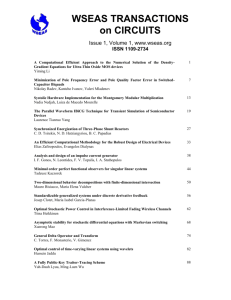
![Chem_Test_Outline[1]](http://s2.studylib.net/store/data/010130217_1-9c615a6ff3b14001407f2b5a7a2322ac-300x300.png)
